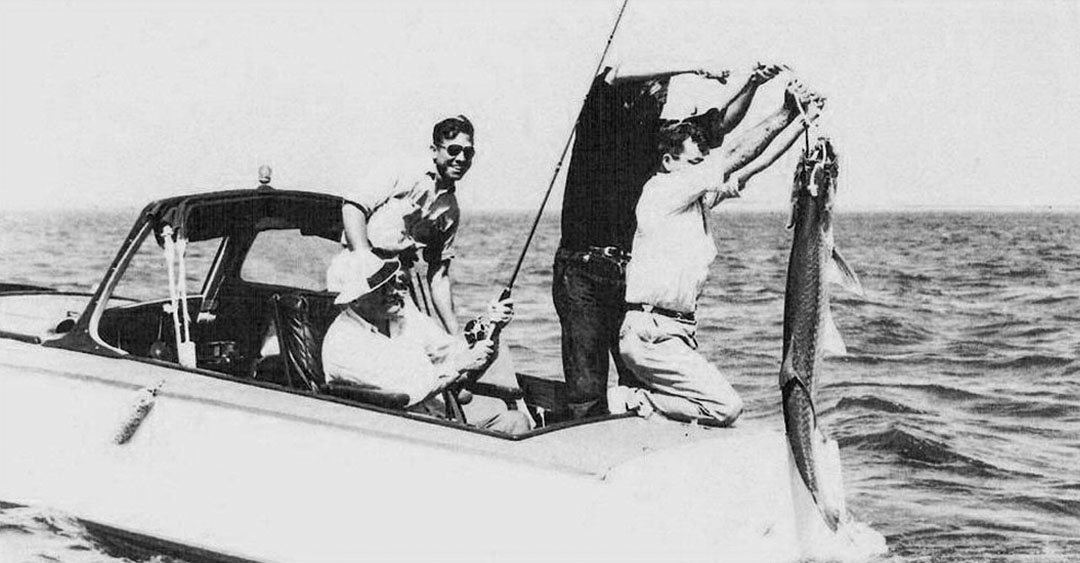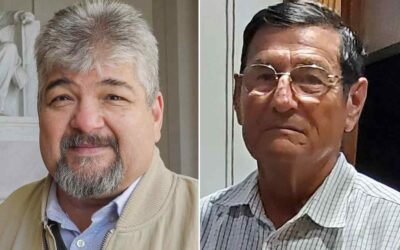
Photo: This is Roosevelt’s big tarpon, whose signed scale hangs in the Tarpon Inn. Ted Mathews is left of the President, while tall son Elliott Roosevelt helps Barney Farley pose the fish for the paparazzi.
Today I will share with you two particularly good questions I have been asked about local history. We begin with the Lydia Ann Lighthouse.
Lydia Ann Lighthouse
The lighthouse was installed in 1857, directly in line with the Aransas Pass, and in that position it marked the straight-on location of the pass to Gulf sailors. Soon, however, the southward movement — migration — of the pass misaligned the lighthouse and pass, the misalignment exceeding a mile before pass migration was arrested (circa 1885). Obviously, the misalignment factor significantly reduced the value of the lighthouse as the marker of the Aransas Pass, leading to the question of why an expensive marker was installed when its obsolescence was guaranteed. Did someone mess up here?
No. When planning the lighthouse, the U.S. Lighthouse Board was fully aware of the southward movement of the Aransas Pass. The board knew that the lighthouse and pass would become increasingly misaligned, but it still went ahead with the 1857 installation. The board did so because marking the Aransas Pass was not the primary purpose of the lighthouse.
The main reason the lighthouse was built was because of the sameness of the Texas Coastal Bend during the mid- 19th century. Namely, the landscape from Pass Cavallo, the top of the bend, to Brazos Santiago Pass, the bottom of the bend, was a line of lookalike sand hills. That sameness disoriented sailors as to their position along this 190 mile coastline.
Our tall (65-foot) light tower served as a highly visible “day-mark,” informing sailors that they were about 60 miles south of Cavallo Pass and 130 miles north of Brazos Santiago; or in other words, a third of the way down, or two-thirds of the way up, the Coastal Bend. Of course the migration of the Aransas Pass had no impact whatsoever on that navigational function, and today our elegant light tower serves as the same coastal way-point it did in 1857.
FDR’s Visit
Many questions about the President Roosevelt fishing trip stem from untruths about that famous event. The following chronological account may help you sort out fact from fiction.
An avid fisherman, FDR arrived off the Aransas Pass aboard a navy destroyer on May 1, 1937. Unaided by any Port Aransas fishermen, the president and his party immediately began fishing outside the jetties, after which they moved from the destroyer to the presidential yacht Potomac, anchored in the mouth of the Lydia Ann Channel. (FDR and party stayed aboard Potomac during the Port Aransas visit.) The next day, the second, was Sunday, and Mr. Roosevelt did not fish on the Sabbath. He wet a line again on the third, by which time several Port Aransas guides had been enlisted.
Early on May 4, Potomac weighed anchor and cruised to Port Isabel, where FDR fished for speckled trout (catching none). The next morning Potomac stood out, and steaming back to Port Aransas, the president did well trolling for kingfish.
Potomac was again at anchor in the Lydia Ann Channel on the morning of May 6, a day — and the next one as well — that FDR attended to affairs of state and did not fish. (The president did recess on the seventh by touring a game preserve on San José Island; however, at no time did he come onto Mustang Island.)
Still hoping to catch a decent size tarpon, which he had not yet done, Mr. Roosevelt fished May 8, his very last fishing day, with local guides Ted Mathews and Barney Farley. Things finally clicked, and at 3:27 p.m. the President boated a nice five-footer, and the paparazzi immortalized the moment. It was a grand way for FDR to end his Port Aransas fishing trip.
The next morning, Sunday, May 9, 1937, Potomac took on water at the Engineers Pier before steaming through the pass on the first leg of the Chief Executive’s journey back to Washington.
(Wikipedia describes FDR returning to Port Aransas to fish again, however there is no record of that happening.)
First published in the Port Aransas South Jetty Nov. 3, 2011.
John Guthrie Ford

Ford authored several books about the history of Port Aransas, transcribed the Mercer Logs, was responsible for multiple exhibits at the Port Aransas Museum and was an interviewer for many of the oral histories for for the PAPHA archives.
Ford also wrote a history column for the Port Aransas South Jetty, called History Corner, and wrote historical articles for the Port Aransas Museum newsletter starting in 2007.
The Dr. John Guthrie Ford History Award is presented by PAPHA for historical scholarship.



